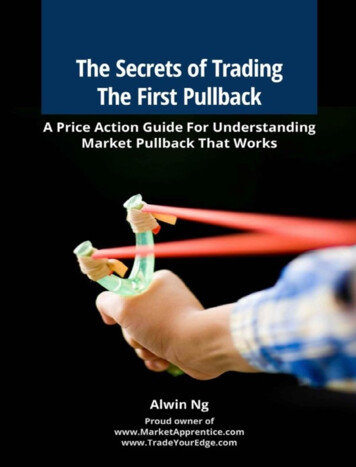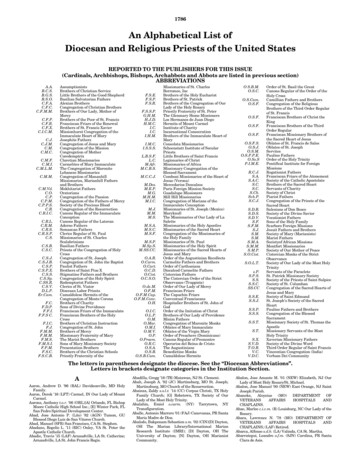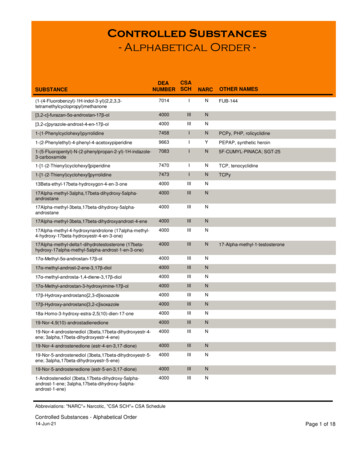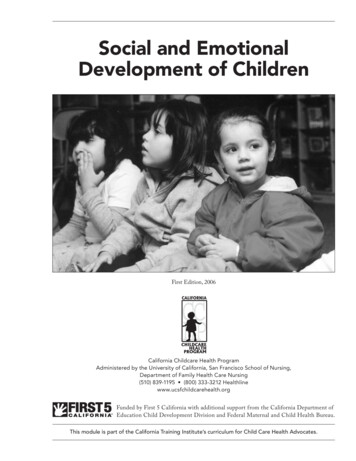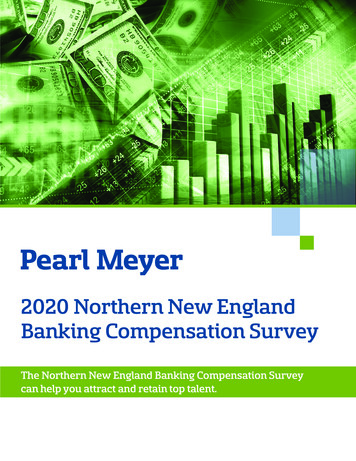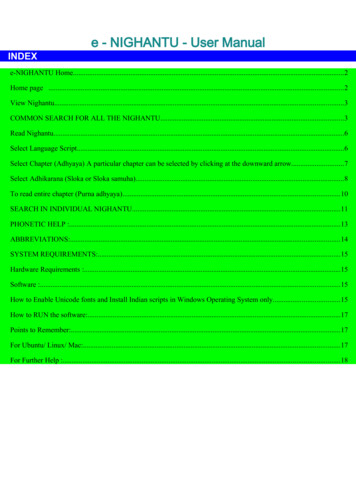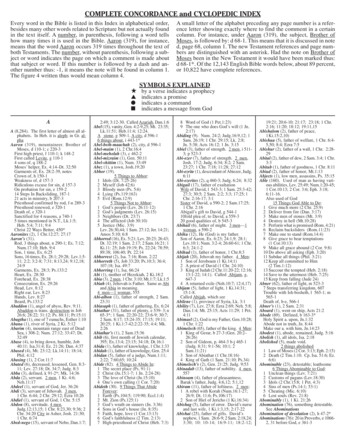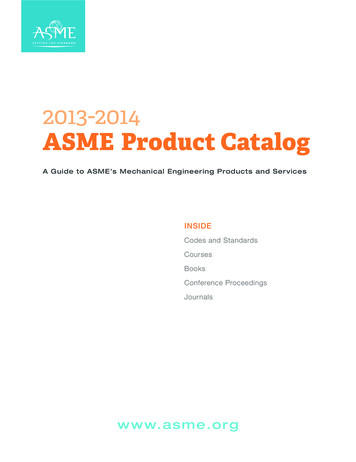
Transcription
Contributors(in alphabetical order) Cheryl Bachelder — former CEO of Popeyes Louisiana Kitchen, speaker, andauthor of the bestselling book Dare to ServeTony Baron — professor at Azusa Pacific University, speaker, and author ofThe Art of Servant Leadership and The Cross and the TowelColleen Barrett — president emeritus of Southwest Airlines and coauthor ofLead with LUVArt Barter — CEO/president of Datron World Communications, found er/CEO of the Servant Leadership Institute, and author of Farmer Able andThe Servant Leadership JournalRichard Blackaby — president of Blackaby Ministries International, minister,speaker, and author or coauthor of numerous books, including Experiencing God and The Seasons of GodJames H. Blanchard — former CEO of Synovus Financial, the first com pany to be inducted into Fortune’s Best Companies to Work for Hallof Fame Ken Blanchard — chief spiritual officer of The Ken Blanchard Companies ,cofounder of the Lead Like Jesus ministry, and coauthor of The New OneMinute Man ag er and more than sixty other booksMargie Blanchard — speaker, leadership con sul tant, coauthor of The OneMinute Man ag er Balances Work and Life, and cofound er/former presidentof The Ken Blanchard CompaniesRobin Blanchard — Colonel (retired), Washington Army National Guard,speaker, facilitator/trainer, strategy con sul tant, and CEO of BlanchardConsultingRenee Broadwell — se nior editor on numerous book proj ects coauthored byKen Blanchard as well as communications and social media for The KenBlanchard Companies.501-70705 ch00 1P.indd 1—-1—0— 126/09/17 5:12 pm
Brené Brown — researcher/storyteller, author of the bestsellers Braving theWilderness, Rising Strong, and Daring Greatly, and widely recognized forher TED Talk on “The Power of Vulnerability”John Hope Bryant — author of The Memo, How the Poor Can Save Capitalismand Love Leadership, and found er/chairman/CEO of Operation HOPE,Inc., and Bryant Group VenturesShirley Bullard — chief administrative officer of The Ken Blanchard Compa nies and h uman resources expert Michael C. Bush — CEO of Great Place to Work , speaker, professor ofentrepreneurship, and author of A Great Place to Work for AllTamika Catchings — four- time All- A merican for University of Tennessee omen’s basketball, ten- time WNBA All- Star and 2011 MVP, four- wtime Olympic gold medalist, owner of Tea’s Me Café, and author ofCatch a StarHenry Cloud — psychologist, leadership coach/con sul tant, and bestsellingauthor of more than twenty books, including Bound aries and The Power ofthe OtherStephen M. R. Covey — author of The Speed of Trust and Smart Trust andcofounder of CoveyLink and the FranklinCovey Global Speed of TrustPracticeHolly Culhane — CEO/founder of Presence Point, Inc., a nonprofit organ ization focused on helping people live into their calling as shepherdleaders, and leadership coach/con sul tantJim Dittmar — president/CEO of 3Rivers Leadership Institute, leadershipcon sul tant, trainer, and coauthor of A Leadership CarolJames Ferrell — managing partner of Arbinger Institute and author orcoauthor of its bestselling books Leadership and Self Deception, TheAnatomy of Peace, and The Outward MindsetMark A. Floyd — speaker, entrepreneur, venture partner at TDF Ventures, andchairman at Ciber, Inc.Jeffrey W. Foley — Brigadier General, U.S. Army (retired), president of LoralMountain Solutions, LLC, speaker, leadership coach, con sul tant, andcoauthor of Rules and Tools for LeadersMarshall Goldsmith — t he world’s leading executive coach and bestsell -1—0— 1—ing author of Triggers, What Got You Here Won’t Get You Th ere, andMojo501-70705 ch00 1P.indd 226/09/17 5:12 pm
Jon Gordon — husband, f ather, speaker, leadership con sul tant, and bestsellingauthor of more than fifteen books, including The Energy Bus, The Carpenter, and The Power of Positive LeadershipCraig Groeschel — founder/senior pastor of Life.Church and bestselling authorof numerous books, including #Struggles and Divine DirectionPhyllis Hennecy Hendry — CEO of the Lead Like Jesus ministry, speaker, andcoauthor of Lead Like Jesus RevisitedChris Hodges — founder/senior pastor of Church of the Highlands, found er/chancellor of Highlands College, and bestselling author of Fresh Air, FourCups, and The Daniel DilemmaPhil Hodges — former Xerox executive, cofounder of the Lead Like Jesusministry, and coauthor of Lead Like Jesus Revisited, Lead Like Jesus forChurches, and The Servant LeaderLaurie Beth Jones — business and life coach, speaker, and author of multiplebestselling books, including Jesus, CEO, and The PathJames M. Kouzes — coauthor of the bestselling book The Leadership Challengeand more than a dozen other books on leadership, and dean’s executivefellow of leadership, Leavey School of Business, Santa Clara UniversityPatrick Lencioni — bestselling author of numerous books, including The FiveDysfunctions of a Team, The Advantage, and The Ideal Team Player, andfound er/CEO of The Table GroupRico Maranto — guardian of the culture and servant leadership evangelist atWaste Connections, Inc.John Maxwell (foreword) — author of many bestselling books, includingThe 21 Irrefutable Laws of Leadership and founder of EQUIP Leader ship, Inc.Erwin Raphael Mc M anus — founder and lead pastor at Mosaic, speaker, andbestselling author of several books, including The Barbarian Way, TheArtisan Soul, and The Last ArrowMiles McPherson — founder and se nior pastor of Rock Church, speaker, andauthor of Do Something! and God in the MirrorMark Miller — V P of High Per for mance Leadership at Chick- fil- A, Inc.,bestselling coauthor of The Secret: What Great Leaders Know and Do, andauthor of Leaders Made H ere and many other booksTom Mullins — founding pastor of Christ Fellowship Church, speaker, and—-1—0— 1author of Passing the Leadership Baton and The Leadership Game501-70705 ch00 1P.indd 326/09/17 5:12 pm
Neal Nybo — ordained pastor, faith- based leadership con sul tant, coach, andauthor of Move Forward, Shut Tight, and Discovering Your Organ ization’sNext StepBarry Z. Posner— endowed professor of leadership and former dean at SantaClara University, scholar, renowned workshop facilitator, and coauthor ofthe award- winning book The Leadership Challenge and many othersDave Ramsey — popu lar radio personality, money management expert, andbestselling author of books that include The Total Money Make over andEntreLeadershipGarry Ridge — CEO/president of WD-40 Com pany, speaker, and coauthor ofbestselling book Helping P eople Win at WorkMark Sanborn — leadership con sul tant, speaker, and author of The Fred Factor,You Don’t Need a Title to Be a Leader, and The Potential Princi pleSimon Sinek — optimist and New York Times bestselling author of Start withWhy, Leaders Eat Last, Together Is Better, and Find Your WhyRaj Sisodia — global thought leader of the Conscious Capitalism movement,speaker, and coauthor of Conscious Capitalism: Liberating the Heroic Spiritof BusinessLarry C. Spears — president of Larry C. Spears Center for Servant Leadership,author, editor, and premiere student and interpreter of the writings ofRobert K. Greenleaf-1—0— 1—501-70705 ch00 1P.indd 426/09/17 5:12 pm
SERVANTLEADERSHIPinACTIONHow You Can Achieve GreatRelationshipsand ResultsEdited by KenBlanchard& Renee Broadwell—-1—0— 1501-70705 ch00 1P.indd 326/09/17 5:12 pm
ContentsForeword by John MaxwellxiIntroduction: Serve First and Lead SecondKen Blanchard and Renee Broadwell1Part OneFundamentals of Servant Leadership1. What Is Servant Leadership?Ken Blanchard72. Characteristics of Servant LeadersLarry C. Spears143. Servant Leadership Is Conscious LeadershipRaj Sisodia194. Servant Leadership at the Speed of TrustStephen M. R. Covey265. Great Leaders SERVEMark Miller346. Servant Leadership: What Does It Really Mean?Mark A. Floyd387. Servant Leaders Create a Great Place to Work for AllMichael C. Bush448. The Leader as ShepherdHolly Culhane 509. The Evolution of Servant LeadershipSimon Sinek501-70705 ch00 1P.indd 756—-1—0— 126/09/17 5:12 pm
viii ContentsP a r t Tw oEle ments of Servant Leadership10. One Question Every Servant Leader Should AskMarshall Goldsmith 6511. In the Ser vice of Others: When Leaders Dare toRehumanize WorkBrené Brown7112. Servant Leaders Celebrate OthersTom Mullins 7713. The Servant Leader’s FocusJames Ferrell8214. What You See Determines How You ServeChris Hodges8715. Compassion: The Heart of Servant LeadershipCraig Groeschel9116. How to Spot Ideal Team PlayersPatrick Lencioni9517. The Servant Leader IdentityLaurie Beth Jones9818. The Four Corners of the Leader’s UniverseHenry Cloud102Part ThreeLessons in Servant Leadership19. Finding Your VoiceJames M. Kouzes and Barry Z. Posner10920. A Lesson from My Father: Washing FeetPhyllis Hennecy Hendry 11521. The Puddle Is Not the Prob lemNeal Nybo-1—0— 1—501-70705 ch00 1P.indd 811826/09/17 5:12 pm
Contents ix22. Five Army- Tested Lessons of Servant LeadershipJeffrey W. Foley12223. A Baptism of LeadershipErwin Raphael Mc Manus12824. Little Things and Big T hingsJon Gordon13325. In Praise of FollowershipMargie Blanchard136Part FourExemplars of Servant Leadership26. Jesus: The Greatest Example of a Servant LeaderKen Blanchard14527. Andrew Young: Partner in Servant Leadershipto Martin Luther King Jr.John Hope Bryant15228. Pat Summitt: Steely Eyes, Servant HeartTamika Catchings15629. Dallas Willard: The Smartest Man I Ever MetTony Baron16230. Henry Blackaby: A Lifelong Servant LeaderRichard Blackaby16731. Frances Hesselbein: To Serve Is to LiveJim Dittmar17132. Charlie “Tremendous” Jones: A Sermon SeenMark Sanborn177Part FivePutting Servant Leadership to Work33. Treat Your People as F amilyColleen Barrett501-70705 ch00 1P.indd 9—-1—0— 118326/09/17 5:12 pm
x Contents34. Developing and Using Servant Leadership in the MilitaryRobin Blanchard18935. Leading Is ServingDave Ramsey 19536. Serving from an HR PerspectiveShirley Bullard19937. It’s How You Treat PeopleJames H. Blanchard20438. How Servant Leadership Has Shaped Our Church CultureMiles McPherson212Part SixServant Leadership Turnarounds39. Out of the Flames, into the LightArt Barter21940. Serve the PeopleCheryl Bachelder22541. Waste Connections: A Servant Leadership Success StoryRico Maranto23142. Don’t Mark My Paper, Help Me Get an AGarry Ridge239Final Comments: The Power of Love, Not the Love of PowerKen Blanchard and Renee Broadwell 246Acknowl edgmentsIndex247000About the Editors249Ser vices Available251-1—0— 1—501-70705 ch00 1P.indd 1026/09/17 5:12 pm
Chapter 1What Is Servant Leadership?Ken BlanchardOkay, let’s get started. As Julie Andrews sang in The Sound of Music, “Let’s start at the very beginning . . .” What is servantleadership all about? In this essay, I’ll give you my thoughts. — KBWhen people hear the phrase servant leadership, they are often confused.Their assumption is that it means man ag ers should be working for their people,who would decide what to do, when to do it, where to do it, and how to doit. If that’s what servant leadership is all about, it doesn’t sound like leadership to them at all. It sounds more like the inmates running the prison, ortrying to please every one.The prob lem is that these folks don’t understand leadership— much lessservant leadership.1 They think you c an’t lead and serve at the same time. Yetyou can, if you understand that there are two parts to servant leadership: a visionary/direction, or strategic, role— the leadership aspect of servantleadership; and an implementation, or operational, role— the servant aspect of servantleadership.Some people say that leadership is r eally the visionary/direction role— doing the right t hing— and management is the implementation role— doing things right. Rather than getting caught in the leadership vs. managementdebate, let’s think of these both as leadership roles.In this book, we focus on leadership as an influence pro cess in which youtry to help p eople accomplish goals. All good leadership starts with a visionary role, as Jesse Stoner and I explain in our book Full Steam Ahead! 2 Thisinvolves not only goal setting, but also establishing a compelling vision that7501-70705 ch01 1P.indd 726/09/17 5:13 pm—-1—0— 1
8-1—0— 1— Fundamentals of Servant Leadershiptells you who you are (your purpose), where y ou’re g oing (your picture of the future), and what will guide your journey (your values). In other words, leadership starts with a sense of direction.I love the saying “a river without banks is a large puddle.”3 The bankspermit the river to flow; they give direction to the river. Leadership is about going somewhere; it’s not about wandering around aimlessly. If people don’thave a compelling vision to serve, the only t hing they have to serve is theirown self- interest.Walt Disney started his theme parks with a clear purpose. He said, “ We’rein the happiness business.” That is very dif fer ent from being in the theme parkbusiness. Being in the happiness business helps cast members (employees) understand their primary role in the com pany.When it comes to a purpose statement, too many organ izations, if theyhave one, make it too complicated. I’ll never forget talking to all of the keyman ag ers of a major bank. Prior to my speech, I asked them to send me theirpurpose statement if they had one, which they did. When I got up in front ofthe group, I told them how much I appreciated their sending me their purpose statement. “Ever since I got it, I’ve slept so much better. Why? B ecauseI put it next to my bed and if I couldn’t sleep at night I would read it.” Thepurpose statement droned on and on. I said, “If I were working with you, Iwould hope you would say ‘We are in the financial peace of mind business—if p eople give us money, we will protect it and even grow it.’ ” Every one laughed because they knew that would be something that all their people could easilyshare and follow.Once you have a clear purpose that tells you who you are, you need todevelop a picture of the f uture so that every one knows where you are g oing.Walt Disney’s picture of the future was expressed in the charge he gave e verycast member: “Keep the same smile on people’s faces when they leave the park aswhen they entered.” Disney d idn’t care whether a guest was in the parktwo hours or ten hours. He just wanted to keep them smiling. A fter all, they were in the happiness business. Your picture of the f uture should focus onthe end results.The final aspect of a compelling vision involves your values, which are there to guide your journey. Values provide guidelines for how you shouldproceed as you pursue your purpose and picture of the f uture. They answerthe questions “What do I want to live by?” and “How?” They need to be clearlydescribed so that you know exactly what be hav iors demonstrate those valuesas being lived.501-70705 ch01 1P.indd 826/09/17 5:13 pm
What Is Servant Leadership? 9The Disney theme parks have four rank- ordered values: safety, courtesy,the show, and efficiency. Why is safety the highest ranked value? Walt Disneyknew that if a guest were to be carried out of one of his parks on a stretcher,that person would not have the same smile on their face leaving the park thatthey had when they entered.The second- ranked value, courtesy, is all about the friendly attitude youexpect at a Disney theme park. Why is it impor tant to know that it’s thenumber- t wo value? Suppose one of the Disney cast members is answering aguest question in a friendly, courteous manner, and he hears a scream that’snot coming from a roller coaster. If that cast member wants to act accordingto the park’s rank- ordered values, he will excuse himself as quickly and politely as pos si ble and race toward the scream. Why? Because the number- onevalue just called. If the values w ere not rank- ordered and the cast memberwas enjoying the interaction with the guest, he might say, “ They’re always yelling at the park,” and not move in the direction of the scream. L ater, somebody could come to that cast member and say, “You w ere the closest to thescream. Why didn’t you move?” The response could be, “I was dealing withour courtesy value.”Life is a series of value conflicts. There will be times when you can’t acton two values at the same time. I have a hunch that’s why Walt Disney putefficiency— running a profitable business— a s the fourth- ranked value. Hewanted to make clear they would do nothing to save money that would put people in danger, nor do a major downsizing in the park that impacted in anegative way their courtesy value.Once an organ ization has a compelling vision, they can set goals and define strategic initiatives that suggest what p eople should be focusing on rightnow. With a compelling vision, these goals and strategic initiatives take onmore meaning and therefore are not seen as a threat, but as part of the biggerpicture.The traditional hierarchical pyramid (see Figure 1.1) is effective for theleadership aspect of servant leadership. Kids look to their parents, players lookto their coaches, and people look to their orga nizational leaders for vision anddirection. While these leaders should involve experienced people in shapingdirection, the ultimate responsibility remains with the leaders themselves andcannot be delegated to others.Once people are clear on where they are going, the leader’s role shifts toa ser vice mindset for the task of implementation— the second aspect of servant leadership. The question now is: How do we live according to the vision501-70705 ch01 1P.indd 926/09/17 5:13 pm—-1—0— 1
10 Fundamentals of Servant LeadershipRESPONSIBLERESPONSIVEFigure 1.1-1—0— 1—Visionary/leadership roleand accomplish the established goals? Implementation is where the servant aspect of servant leadership comes into play.Most organ izations and leaders get into trou ble in the implementationphase of the leadership pro cess. With self- serving leaders at the helm, the traditional hierarchical pyramid is kept alive and well. When that happens,who do people think they work for? The people above them. The minute youthink you work for the person above you for implementation, you are assuming that person— your boss—is responsible and your job is being responsive tothat boss and to his or her whims or wishes. Now “boss watching” becomesa popu lar sport and people get promoted on their upward- influencing skills.As a result, all the energy of the organ ization is moving up the hierarchy, awayfrom customers and the frontline folks who are closest to the action. Whatyou get is a duck pond. When there is a conflict between what the customerswant and what the boss wants, the boss wins. You have people quacking likeducks: “It’s our policy.” “I just work here.” “Would you like me to get my supervisor?” Servant leaders know how to correct this situation by philosophically turning the traditional hierarchical pyramid upside down when it comesto implementation (see Figure 1.2).When that happens, who is at the top of the organ ization? The customercontact people. Who is really at the top of the organ ization? The customers.Who is at the bottom now? The “top” management. As a result, who worksfor whom when it comes to implementation? You, the leader, work for your people. This one change, although it seems minor, makes a major difference.The difference is between who is responsible and who is responsive.When you turn the orga nizational pyramid upside down, rather thanyour people being responsive to you, they become responsible— able to501-70705 ch01 1P.indd 1026/09/17 5:13 pm
What Is Servant Leadership? 11RESPONSIBLERESPONSIVEFigure 1.2Implementation/servant rolerespond— a nd your job as the leader/manager is to be responsive to your people. This creates a very dif fer ent environment for implementation. If youwork for your p eople as servant leaders do, what is the purpose of being a man ag er? To help your people become ea gles rather than ducks and soar abovethe crowd— accomplishing goals, solving prob lems, and living according tothe vision.4As a customer, you can always tell an organ ization that is run by a self- serving leader. Why? Because if you have a prob lem and go to a frontline customer contact person to solve it, you are talking to a duck. They say, “It’s ourpolicy,” quack quack; “I didn’t make the rules,” quack quack; “Do you wantto talk to my supervisor?” quack quack.Several years ago, a friend of mine had an experience in a departmentstore that illustrates this point well. While shopping, he realized he neededto talk to his wife and he had left his cell phone at home. He asked a salesperson in the men’s department if he could use the telephone.“No,” the salesperson said.My friend replied, “You have to be kidding me. I can always use the phoneat Nordstrom.”The salesperson said, “Look, buddy, they d on’t let me use the phone here.Why should I let you?”That certainly isn’t what servant leadership is all about. Who do you thinkthat salesperson worked for— a duck or an ea gle? Obviously, a supervisoryduck. Who does that duck work for? Another duck, who works for anotherduck. And who sits at the top of the organ ization? The head mallard— a greatbig duck. If the salesperson had worked for an ea gle, both he and the customer would have been able to use the phone!501-70705 ch01 1P.indd 1126/09/17 5:13 pm—-1—0— 1
12-1—0— 1— Fundamentals of Servant LeadershipNow contrast that with the ea gle experience one of my colleagues hadwhen he went to Nordstrom one day to get some perfume for his wife. The woman behind the counter said, “I’m sorry; we don’t sell that perfume inour store. But I know where I can get it in the mall. How long w ill you bein our store?”“About 30 minutes,” my colleague said.“Fine. I’ll go get it, bring it back, gift wrap it, and have it ready for youwhen you leave.”This woman left Nordstrom, went to another store, got the perfume mycolleague wanted, came back to Nordstrom, and gift wrapped it. You knowwhat she charged him? The same price she had paid at the other store. So Nordstrom didn’t make any money on the deal, but what did they make? A raving fan customer.To me, servant leadership is the only way to guarantee great relationshipsand results. That became even clearer to me when I realized that the two leadership approaches I am best known for around the world— The One MinuteMan ag er and Situational Leadership II (SLII )— are both examples of servant leadership in action. A fter all, what’s the First Secret of The One Minute Man ag er? One Minute Goals. All good per for mance starts with clear goals— which is clearly partof the leadership aspect of servant leadership. Once people are clear on goals,an effective One Minute Man ag er wanders around and tries to catch p eople doing something right so that they can deliver a One Minute Praising— theSecond Secret. If the person is doing something wrong or not performing aswell as agreed upon, a One Minute Re- Direct is appropriate— t he Third Secret. When effective One Minute Man a g ers deliver praisings and re- directs, they are engaging in the servant aspect of servant leadership— theyare working for their p eople to help them win— accomplish their goals.5Situational Leadership II6 also has three aspects that generate both g reatrelationships and results: goal setting, diagnosis, and matching. Once cleargoals are set, an effective SLII leader works with their direct report to diagnose the direct report’s development level— competence and commitment—on each specific goal. Together they then determine the appropriate leadershipstyle— the amount of directive and supportive be hav ior— that will match theperson’s development level on each goal so that the man ag er can help themaccomplish their goals. The key here, in the servant aspect of servant leadership, is for man ag ers to remember they must use dif fer ent strokes for dif fer ent folks and also dif fer ent strokes for the same folks, depending on the goaland the person’s development level.501-70705 ch01 1P.indd 1226/09/17 5:13 pm
What Is Servant Leadership? 13Why are the concepts of The One Minute Man ag er and SLII so widelyused around the world? I think it’s b ecause they are clear examples of servantleadership in action. Both concepts recognize that vision and direction— theleadership aspect of servant leadership—is the responsibility of the traditionalhierarchy. The servant aspect of servant leadership is all about turning the hierarchy upside down and helping every one throughout the organ ization develop great relationships, get great results, and, eventually, delight theircustomers.Notes1. Ken Blanchard et al., Leading at a Higher Level (Upper Saddle River, NJ:FT Press, 2006, 2010). See chapter 14 for a more extensive discussion ofwhat servant leadership is all about.2. See Ken Blanchard and Jesse Stoner, Full Steam Ahead: Unleash the Powerof Vision in Your Com pany and Your Life (San Francisco: Berrett- Koehler,2003, 2011) for more about the visionary role of leadership.3. This expression was coined by Alan Randolph. See Ken Blanchard, JohnCarlos, and Alan Randolph, Empowerment Takes More Than a Minute (SanFrancisco: Berrett- Koehler, 1996).4. Ken first heard this distinction between ducks and ea gles from author andlegendary personal growth guru Wayne Dyer.5. Ken Blanchard and Spencer Johnson, The One Minute Man ag er (New York:William Morrow, 1982, 2003). See also their The New One MinuteMan ag er (New York: William Morrow, 2015).6. Ken Blanchard first developed Situational Leadership with Paul Hersey inthe late 1960s. It was in the early 1980s that Ken and founding associatesof The Ken Blanchard Companies— Margie Blanchard, Don Carew,Eunice Parisi- Carew, Fred Finch, Laurie Hawkins, Drea Zigarmi, andPatricia Zigarmi— created Situational Leadership II. The best descriptionof this thinking can be found in Ken Blanchard, Patricia Zigarmi, andDrea Zigarmi, Leadership and the One Minute Man ag er (New York:William Morrow, 1985, 2013).—-1—0— 1501-70705 ch01 1P.indd 1326/09/17 5:13 pm
About the EditorsKen BlanchardKen Blanchard, one of the most influential leadership experts in the world, isthe coauthor of the iconic best seller The New One Minute Man ag er and morethan sixty other books that have combined sales of more than twenty- one million copies in forty- t wo languages. In 2005 he was inducted into Amazon’sHall of Fame as one of the top twenty- five bestselling authors of all time.Ken is the cofounder and chief spiritual officer of The Ken BlanchardCompanies, an international training and consulting firm that he and his wifeMargie began in 1979 in San Diego, California. In addition to being a renowned speaker and con sul tant, Ken is also cofounder of Lead Like Jesus, aglobal ministry committed to helping people become servant leaders.Born in New Jersey and raised in New Rochelle, New York, Ken receiveda master’s degree from Colgate University and a bachelor’s and PhD from Cornell University.Find out more about Ken and his books at www.kenblanchardbooks . com,and follow him on Twitter @kenblanchard and on Facebook at www.face book . com / KenBlanchardFanPage.Renee BroadwellRenee Broadwell has been an editor with The Ken Blanchard Companies formore than ten years, working directly with Ken as lead editor on several bookproj ects including Lead with LUV, Legendary Ser vice, Fit at Last, Collaboration Begins with You, Lead Like Jesus Revisited, and The Simple Truths of Ser vice. She also serves as editor on articles, blogs, other social media, and specialproj ects, partnering with vari ous Blanchard departments including Communications, Marketing, and the executive suite.Renee previously held positions with Alaska Airlines, Nordstrom, Inc.,and The Art Institute of California- San Diego. She and her husband Grantlive in Escondido, California, and their grown children live nearby.501-70705 ch01 1P.indd 24926/09/17 5:13 pm—-1—0— 1
Ser v ices AvailableThe Ken Blanchard CompaniesThe Ken Blanchard Companies is committed to helping leaders andorgan izations perform at a higher level. Ken, his com pany, and BlanchardInternational— a global network of world- class con sul tants, trainers, andcoaches— have been helping organ izations improve workplace productivity, employee satisfaction, and customer loyalty around the world for de cades.If you would like information on the ser vices, programs, and productsoffered by Blanchard International, please contact us.The Ken Blanchard CompaniesWorld Headquarters125 State PlaceEscondido, California 92029United StatesPhone: 1-760-489-5005Email: International@kenblanchard.comWebsite: www . kenblanchard . comLead Like JesusCEO or teacher, pastor or parent, shop keeper or student—if you want to knowmore about the Lead Like Jesus organ ization, go to www.leadlikejesus . comor follow LLJ on Twitter @leadlikejesus, or on Facebook at www.facebook . com / Lead - Like - Jesus - 137597419629033.—-1—0— 1501-70705 ch01 1P.indd 25126/09/17 5:13 pm
Join Us OnlineVisit the Ken Blanchard Books website: www.kenblanchardbooks . comLearn about Ken and his books. Read his blog. Meet his coauthors. Browsehis library.Follow Ken’s Twitter Updates @kenblanchardReceive timely messages and thoughts from Ken. Find out about books he’sreading, events he’s attending, and what’s on his mind.Join the Ken Blanchard Fan Page on Facebook: www.facebook . com/ KenBlanchardFanPageBe part of our inner circle and follow Ken’s Fan Page on Facebook. Meet otherfans of Ken and his books. Access videos and photos and get invited to special events.Join Conversations with Ken Blanchard at www.howwelead . orgBlanchard’s blog was created to inspire positive change. It is a public ser vicesite devoted to leadership topics that connect us all. This site is nonpartisan,secular, and does not solicit or accept donat
Wilderness, Rising Strong, and Daring Greatly, and widely recognized for her TED Talk on “The Power of Vulnerability” John Hope Bryant— of utahro The Memo, How the Poor Can Save Capitalism and Love Leadership, and founder/chairm
